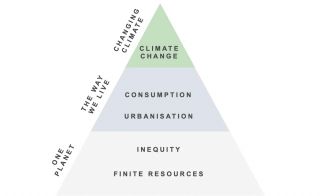
www.buildingsandcities.org/insights/commentaries/blind-spots-energy-policy.html
Blind Spots in Energy Policy

Why emerging (smart) technologies are hindering energy outcomes
As a policy practitioner who leads a national organisation representing households and small businesses in shaping the future of Australia's energy system, Lynne Gallagher (Energy Consumers Australia) responds to the Buildings & Cities special issue, Energy, Emerging Technologies and Gender in Homes. Insights from lived experience reveal blind spots in the design, provision and use of smart tech that adversely affect energy outcomes.
The special issue's editorial (Strengers et al. 2022) states: 'the special collection explores a key question in the energy transition: how are visions, relationships and practices with emerging technologies gendered and what does this mean for home relations and energy outcomes?' My comments focus on how this question relates to energy outcomes, as the implications for home relations are well considered by the authors.
The meaning of the concepts of 'energy transition' and 'energy outcomes' can be linked to the United Nation's Sustainable Development Goals of which (Goal 7) is Affordable and Clean Energy. It aims to 'ensure access to affordable, reliable, sustainable and modern energy for all'. This means that the aspirational goal of the energy transition is not only to complete the shift to renewable energy, but to also address the current inequities with many communities lacking access to reliable or affordable energy.
Blind spots and their consequences
Within this global context, a more local one exists and pertains to the energy outcomes for homes - the focus of the special issue. What comes through clearly in the evidence of people's lived experience and the analysis provided by the various authors is that gender blindness in industry visions and technology design is inhibiting the value to be gained from the uptake and use of technologies in the home. How is this playing out in the Australian context? To the extent that people can change their habits and social practices, they are not taking advantage of the availability of solar generation when energy is abundant. This results in situations when energy generation is being curtailed, during times that are quaintly referred to as 'system minimum demand'.
For the technology enthusiasts, the solution to this failure is to simply add more technology in the various forms of storage including home batteries, electric vehicles and (less often considered) hot water storage. While this is all possible, and local storage will play a necessary role in levelling out the availability of electricity produced by solar generation, some adaptation of consumption to the diurnal pattern of renewable generation is desirable across the community. The less the adaptation, the greater the total system costs to ensure system security and reliability, and the pressure on affordability. This is true for any electricity system, large or small, in which homes are connected.
Another inescapable insight from the lived experience reported in several research papers is the misalignment between the work being done by men and the work being done by women, whether that is in the home or energy professionals brokering energy access in the Global South. What comes through clearly is how often energy expertise is expressed as a desire to exercise control over those seen as not having that same expertise. As many authors observe, this can be true irrespective of whether the intentions - or values - of the expert are benign or not. It is therefore not surprising that the energy system design also embodies this approach of knowing best, the greater good and taking control over consumers - whether that's controlling their electricity use, generation or storage technologies in their homes (collectively now being referred to as consumer energy resources, and not distributed energy resources).
This technological or 'techspert' determinism is as doomed to fail at system level as well as in the home and communities because it ignores the diversity in the needs and patterns of energy use that are connected to people's lives and livelihoods. To successfully achieve the energy transition, we need to shift emphasis away from energy experts and system design exercising power over others, to embedding the power for people in homes and communities to act in concert with others, for both individual and mutual benefits (Leadbeater et al. 2021). Unless consumers are empowered to have agency in the decisions they make in the uptake and interactions with technology and energy use, we risk unintended and possibly unseen harmful consequences that result in a backlash against the energy transition.
An intoxication with technology - and related to that the values of self-reliance and independence - is also contributing to another form of blindness, to the value of energy inclusion. Not all homes have the means and opportunity to invest in technology, given differences in housing stock, tenure and income as well as capability. There is a growing energy divide in Australia (Gallagher 2023), where analysis from Energy Consumers Australia's survey finds that currently half of all households pay < 3% of their income on electricity costs, while for the remaining half pay from 3% to >12% (Energy Consumers Australia 2022). There is more that could be explored in researching the significant role of values in supporting energy inclusion, as part of system and policy design that encompasses economic opportunity, poverty, housing and mobility as well as energy. The value of care is one of the three themes in this special issue, but other values such as sharing and connection have also received attention in other important research into values (Parkhill et al. 2013; Alexander et al. 2020).
A future research agenda
Reflecting on the special issue provides an opportunity to consider "what next?"
Recently in speaking at a research conference, I said that 'people power' is at the heart of the transformation of our energy system, from one that is carbon-based to one that is net zero by 2050, based on renewables and storage (Gallagher 2023). Yet this area is the least researched i.e. where we have the least knowledge of the pathways that people will take to both invest in technology and in retrofitting to achieve zero carbon homes and businesses, or the changes they may make in social practices that determine how much and when electricity is used.
This special issue has been invaluable in exploring the role of gender in relation to home relations and energy outcomes, while acknowledging its limitations in respect of the diversity of households and the opportunities for further research.
Another opportunity for further research is to explore theories of organisation and household decision making in the context of relationships across a range of different households, including households with and without children, single adult households, same-sex households, multi-generation households, shared households as well as couple households. Just one example is the research Energy Consumers Australia funded in 2019 into how different household segments set the 'rules of engagement' for connected-home technologies in the context of electricity use and monitoring (Letheren et al. 2019).
Realising the goal of affordable and clean energy for all, means understanding and designing for diversity across a range of dimensions. Design thinking must anticipate and support markets and business models that create authentic value propositions for consumers, that are simple to understand, easy to action and where consumers have agency. This design thinking needs evidence and social science knowledge of people, place and practices as its foundation. This special issue plays a valuable role in expanding and deepening this knowledge.
References
Alexander, D., Dwyer, S., Briggs, C. & Riedy, C. (2020). DER customer insights: values & motivations, institute of sustainable futures. https://arena.gov.au/knowledge-bank/insight-into-distributed-energy-resource-customers/
Energy Consumers Australia. (2022). Energy consumer sentiment survey. December 2022. https://ecss.energyconsumersaustralia.com.au/sentiment-survey-dec-2022/
Gallagher, L. (2023). The power to shift the energy system. (Speech to the Energy Research Institutes Council of Australia, 3rd State of Energy Research Conference, January 2023.) https://energyconsumersaustralia.com.au/news/the-power-to-shift-the-system
Leadbeater, C. & Winhall, J. (2021). The power to shift a system: system innovation initiative. https://www.systeminnovation.org/article-the-power-to-shift-a-system
Letheren, K., Russell-Bennett, R., Mulcahy, R. and McAndrew, R. (2019). Rules of (household) engagement: technology as manager, assistant and intern. European Journal of Marketing, 53 (9), pp.1934-1961.
Parkhill, K.A., Demski, C., Butler, C., Spence, A. & Pidgeon, N. (2013). Transforming the UK energy system: public values, attitudes and acceptability - Synthesis Report. London: UKERC. https://ukerc.ac.uk/publications/transforming-the-uk-energy-system-public-values-attitudes-and-acceptability/
Strengers, Y., Gram-Hanssen, K., Dahlgren, K. & Aagaard, L.K. (2022). Energy, emerging technologies and gender in homes. Buildings and Cities, 3(1), 842-853. http://doi.org/10.5334/bc.273
Latest Peer-Reviewed Journal Content
Youth engagement in urban living labs: tools, methods and pedagogies
N Charalambous, C Panayi, C Mady, T Augustinčić & D Berc
Co-creating urban transformation: a stakeholder analysis for Germany’s heat transition
P Heger, C Bieber, M Hendawy & A Shooshtari
Placemaking living lab: creating resilient social and spatial infrastructures
M Dodd, N Madabhushi & R Lees
Church pipe organs: historical tuning records as indoor environmental evidence
B Bingley, A Knight & Y Xing
A framework for 1.5°C-aligned GHG budgets in architecture
G Betti, I Spaar, D Bachmann, A Jerosch-Herold, E Kühner, R Yang, K Avhad & S Sinning
Net zero retrofit of the building stock [editorial]
D Godoy-Shimizu & P Steadman
Co-learning in living labs: nurturing civic agency and resilience
A Belfield
The importance of multi-roles and code-switching in living labs
H Noller & A Tarik
Researchers’ shifting roles in living labs for knowledge co-production
C-C Dobre & G Faldi
Increasing civic resilience in urban living labs: city authorities’ roles
E Alatalo, M Laine & M Kyrönviita
Co-curation as civic practice in community engagement
Z Li, M Sunikka-Blank, R Purohit & F Samuel
Preserving buildings: emission reductions from circular economy strategies in Austria
N Alaux, V Kulmer, J Vogel & A Passer
Urban living labs: relationality between institutions and local circularity
P Palo, M Adelfio, J Lundin & E Brandão
Living labs: epistemic modelling, temporariness and land value
J Clossick, T Khonsari & U Steven
Co-creating interventions to prevent mosquito-borne disease transmission in hospitals
O Sloan Wood, E Lupenza, D M Agnello, J B Knudsen, M Msellem, K L Schiøler & F Saleh
Circularity at the neighbourhood scale: co-creative living lab lessons
J Honsa, A Versele, T Van de Kerckhove & C Piccardo
Positive energy districts and energy communities: how living labs create value
E Malakhatka, O Shafqat, A Sandoff & L Thuvander
Built environment governance and professionalism: the end of laissez-faire (again)
S Foxell
Co-creating justice in housing energy transitions through energy living labs
D Ricci, C Leiwakabessy, S van Wieringen, P de Koning & T Konstantinou
HVAC characterisation of existing Canadian buildings for decarbonisation retrofit identification
J Adebisi & J J McArthur
Simulation and the building performance gap [editorial]
M Donn
Developing criteria for effective building-sector commitments in nationally determined contributions
P Graham, K McFarlane & M Taheri
Join Our Community

The most important part of any journal is our people – readers, authors, reviewers, editorial board members and editors. You are cordially invited to join our community by joining our mailing list. We send out occasional emails about the journal – calls for papers, special issues, events and more.
We will not share your email with third parties. Read more



Latest Commentaries
COP30 Report
Matti Kuittinen (Aalto University) reflects on his experience of attending the 2025 UN Conference of the Parties in Belém, Brazil. The roadmaps and commitments failed to deliver the objectives of the 2025 Paris Agreement. However, 2 countries - Japan and Senegal - announced they are creating roadmaps to decarbonise their buildings. An international group of government ministers put housing on the agenda - specifying the need for reduced carbon and energy use along with affordability, quality and climate resilience.
Building-Related Research: New Context, New Challenges
Raymond J. Cole (University of British Columbia) reflects on the key challenges raised in the 34 commissioned essays for Buildings & Cities 5th anniversary. Not only are key research issues identified, but the consequences of changing contexts for conducting research and tailoring its influence on society are highlighted as key areas of action.